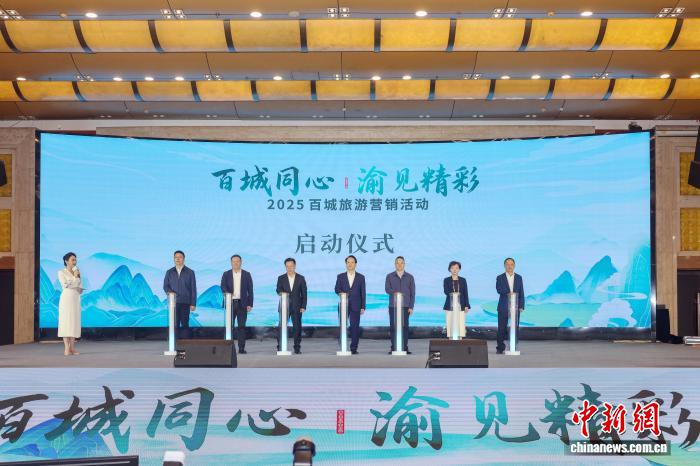On October 23, the “Hundred Cities United, Chongqing Shines” 2025 Hundred Cities Tourism Marketing Campaign was held in Jiangbei District, Chongqing. Tourism colleagues from across the country gathered to build bridges for urban tourism cooperation through policy interpretation, resource promotion, and alliance signings, playing a symphony of coordinated development for tourism across a hundred cities.
“Chongqing is the world’s largest mountain-river metropolis and a nationally renowned historical and cultural city. With its unique landscape and cultural charm, it is writing a glorious chapter in tourism development for the new era,” said a representative from the Chongqing Culture and Tourism Development Committee. Chongqing is coordinating tourism resources across the region, fully building three major tourism brands: “World Mountain-River Metropolis,” “Magnificent Yangtze River Three Gorges,” and “Colorful Wuling,” while collaborating with Sichuan to accelerate the joint construction of the Ba-Shu Cultural Tourism Corridor.
A representative from Jiangbei District stated that in recent years, the district has persisted in using culture to shape tourism and tourism to promote culture, being selected as part of the second batch of national culture and tourism consumption pilot cities. Since the beginning of this year, Jiangbei District has received over 60 million domestic and international tourists. “We sincerely invite everyone to personally experience Jiangbei’s vitality, charm, and appeal; we eagerly hope that tourism enterprises and investors will further favor Jiangbei, enter Jiangbei, invest in Jiangbei, and establish businesses in Jiangbei.”
Ancient capital charm and ethnic customs, plateau mysteries and Jiangnan elegance… During the event, representatives from cities including Chongqing, Lijiang, Changdu, Ya’an, Guiyang, Hefei, Shaoxing, and Suining promoted their local landscapes, cultural history, and characteristic tourism routes.
The event also featured a signing ceremony for the “Mutual Tourist Source Market Alliance.” The signing parties will cooperate in establishing regular communication mechanisms, promoting resource sharing, strengthening mutual tourist exchanges, deepening tourism cooperation, and maintaining market order. They will jointly create culturally influential tourism products, enhance the comprehensive strength and market competitiveness of their cultural tourism industries, and promote innovation and development in the cultural tourism sector.
A relevant representative from the Chongqing Culture and Tourism Development Committee stated that in the next step, Chongqing will join hands with more cities and tourism enterprises to further co-build and share, expand and strengthen the “Hundred Cities Tourism Marketing” brand, promote resource integration and market coordination, create integrated online and offline promotion channels, advance regional tourism collaborative development, and contribute to the construction of a unified national cultural tourism market.
Chongqing
Chongqing is a major city in southwestern China at the confluence of the Yangtze and Jialing Rivers. Historically, it served as the provisional capital of China during the Second Sino-Japanese War (1937-1945). Today, it is a sprawling megacity and a key economic hub, famous for its mountainous terrain, hot pot cuisine, and foggy weather.
Jiangbei District
Jiangbei District is a central urban district of Chongqing, China, located north of the Jialing River. Historically an important area for trade and transportation, it has developed from ancient towns into a modern commercial and financial hub for the city.
Yangtze River Three Gorges
The Three Gorges are a stunning natural canyon landscape along China’s Yangtze River, renowned for their breathtaking scenery of steep cliffs and mountains. Historically, they have been a source of inspiration for Chinese artists and poets for centuries. The region’s history was profoundly altered in the modern era by the construction of the Three Gorges Dam, which created a massive reservoir and submerged many historical and archaeological sites.
Wuling
Wuling refers to the Wuling Mountain Range, a scenic area in China spanning parts of Hunan, Hubei, and Guizhou provinces. It is renowned for its spectacular quartzite sandstone peaks, lush forests, and its status as a UNESCO Global Geopark. Historically, the region has been inhabited by the Tujia and Miao ethnic minorities for centuries, contributing to its rich cultural heritage.
Ba-Shu Cultural Tourism Corridor
The Ba-Shu Cultural Tourism Corridor is a modern initiative designed to showcase the shared historical and cultural heritage of the ancient Ba and Shu civilizations, located in present-day Sichuan and Chongqing. It connects numerous historical sites, ancient towns, and natural landscapes to promote cultural tourism. The corridor aims to preserve and revitalize the legacy of this region, which was a cradle of a unique and influential culture in early Chinese history.
Lijiang
Lijiang is a historic city in Yunnan Province, China, renowned for its well-preserved ancient town, a UNESCO World Heritage Site. Its history dates back over 800 years, and it was a crucial hub for trade along the ancient Tea Horse Road. The city is also famous for its unique Naxi ethnic minority culture and its intricate canal system.
Changdu
Changdu, also known as Chamdo, is a prefecture-level city in eastern Tibet with historical significance as a major trading hub along the ancient Tea Horse Road. It played a pivotal role in the 1950 Battle of Chamdo, a key military conflict preceding Tibet’s incorporation into the People’s Republic of China. Today, it remains an important cultural and economic center in the Tibet Autonomous Region.
Ya’an
Ya’an is a prefecture-level city in Sichuan province, China, historically significant as a major hub on the ancient Southern Silk Road. It is perhaps best known internationally as the hometown of the giant panda, with its Bifengxia Panda Base being a world-renowned conservation and research center. The city and its surrounding area are also famous for producing high-quality tea, particularly Mengding tea, which has been cultivated for over two thousand years.



